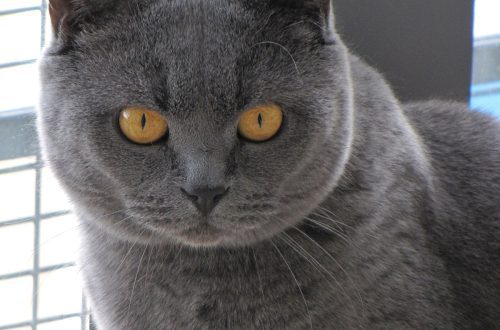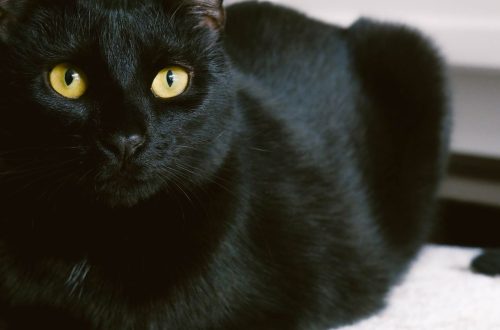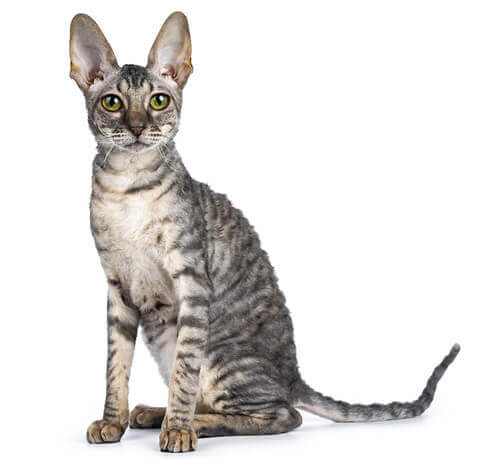
Cornish Rex
The Cornish Rex is an exquisite breed of cat with a very soft and curly coat that embodies the most striking features of a small fidget. His playfulness and curiosity will not let you get bored even for a minute!
Contents
- Characteristics of Cornish Rex
- Basic moments
- History of the Cornish Rex breed
- Video: Cornish Rex
- Appearance of the Cornish Rex
- Photo Cornish Rex
- Personality of the Cornish Rex
- Education and training
- Care and maintenance
- Health and disease of the Cornish Rex
- How to choose a kitten
- Photo of Cornish Rex kittens
- How much is a Cornish Rex
Characteristics of Cornish Rex
| Country of origin | Great Britain |
| Wool type | Shorthair |
| Height | 23–27 cm |
| Weight | 3–5 kg |
| Age | 14–15 years old |
Basic moments
- The Cornish Rex is considered one of the most active cat breeds, so get ready to become the owner of a playful fidget in advance.
- This rare cat breed has a curly coat that is so soft that many compare it to astrakhan or velvet.
- The graceful body of the animal hides a strong and well-developed musculature, which helps him get to the highest and hard-to-reach corners of the apartment.
- “English” and “Americans” have minor differences in their appearance: for example, the former look more massive and large.
- The Cornish Rex loves to take part in the life of his family and therefore often spins under his feet, “commenting” on what is happening with a joyful meow.
- It gets along well with children, does not conflict with other animals, but the feeling of jealousy is still inherent in this breed.
- Cornish Rex do not like to spend their days alone, so try to give your pet as much of your free time as possible.
- Representatives of the breed are perfectly trainable due to their developed intellect and do not create problems in the process of education.
- They are unpretentious in care and therefore will not cause difficulties even for people without experience in keeping cats.
- Animals are famous for their excellent health and the almost complete absence of genetic diseases.
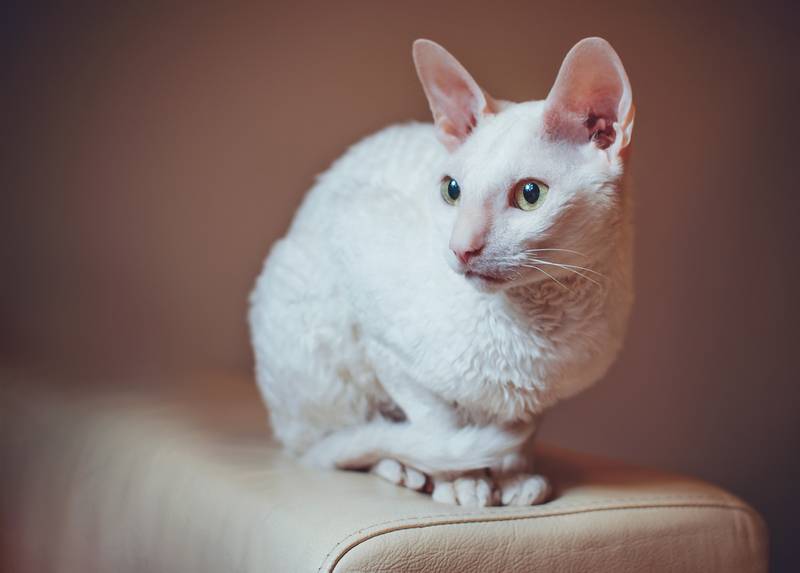
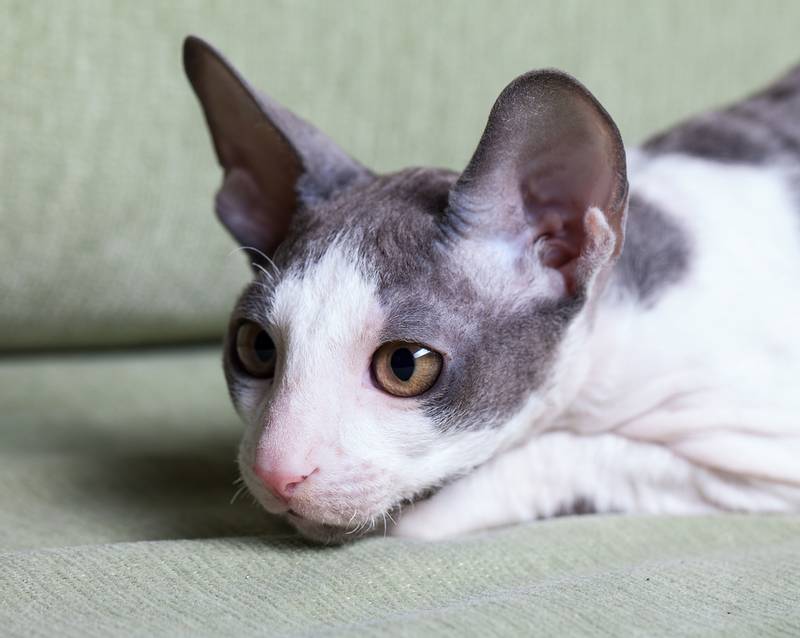
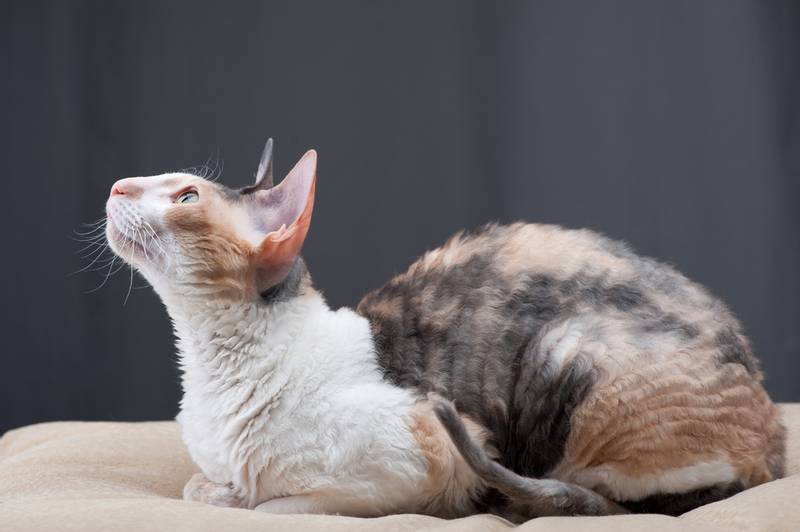
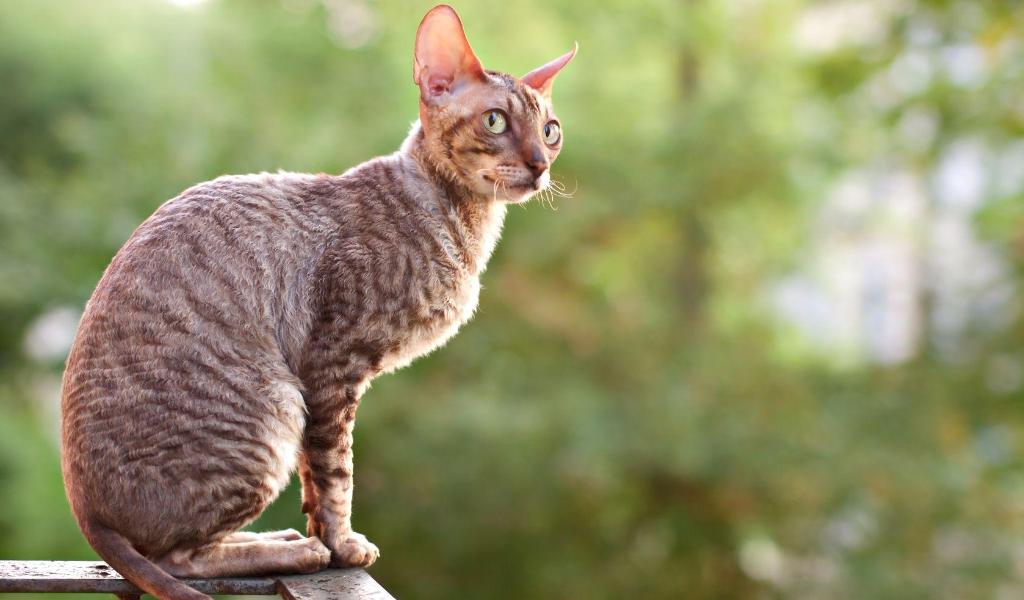
Cornish Rex will certainly be the main reason for your carefree smile and frequent chuckles. The mobility and inexhaustible energy of the cat give it a resemblance to a perpetual motion machine, which was never invented, but in some incredible way found its reflection in a four-legged beauty. The Cornish Rex is the animal that will reach the highest box, the most inaccessible corner of your apartment, and agile and surprisingly strong paws will become assistants. Do not opt for this breed if you like more independent and calm cats.
History of the Cornish Rex breed
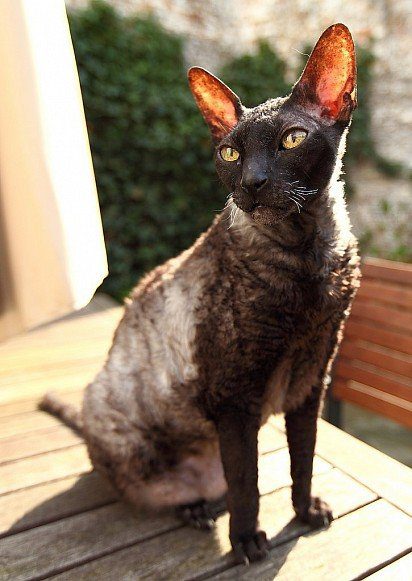
Few people know that the world could see a new breed much earlier than in the middle of the 20th century. A few years earlier, its first representative was seen in Berlin near one of the hospitals. Passers-by did not pay due attention either to the kitten’s charm or to its short, curly coat: the post-war years forced the Germans to think about more important things than a homeless, albeit unusual, animal. For this reason, the Cornish Rex breed officially began its existence in 1950, and this is due to an ordinary accident.
On a July morning, Nina Ennismore, the owner of a small farm near the village of Bodmin Moor in Cornwall, was in for a surprise in the face of an unusual kitten, which was radically different from her fellows from the litter. While the four-legged inhabitants of English farms had a dense coat, a round head and an impressive skeleton, a newborn baby became the owner of a curly coat, a flexible body and a wedge-shaped head. Locator ears gave the kitten a resemblance to a representative of an extraterrestrial civilization, and the chosen nickname was no less eccentric: the baby was named Kalibunker.
Miss Ennismore was fascinated by the new ward, seeing in him something more than a pronounced mutation. However, because of her short-sightedness, the woman almost put an end to the Cornish Rex, having decided to take the grown-up pet for castration. Fortunately, the veterinarian whom Nina turned to had a solid knowledge base in the field of genetics and saw in Kalibunker a possible progenitor of the new breed. Having listened to the recommendations of the doctor, Miss Ennismore turned to breeders who at that time enjoyed authority and were highly respected people – A. K. Jude and B. Stirling-Webb.
Dr. Jude confirmed the words of the veterinarian: Kalibunker is the first representative of a new breed that is fundamentally different from those already registered. Responsibility for its development fell on the shoulders of Nina Ennismore, who came up with the name – Cornish Rex. The first part of the word indicated the birthplace of the breed, while the second did not speak of an aristocratic origin, but served as a kind of reference to the woman’s former activities. So, she bred astrex rabbits, which, like Kalibunker, had curly hair.
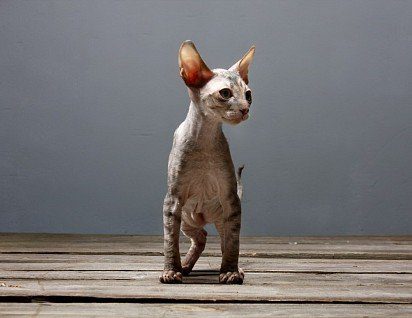
Jude and Stirling-Webb first proposed testing the kitten’s mutation for resistance. When the animal reached puberty, Miss Ennismore crossed him with his mother Serena, who was an ordinary mongrel cat. As a result of mating, three kittens were born, two of which had the same remarkable appearance as Kalibunker. Unfortunately, only one of them survived, later named Poldu.
Nina continued the experiment of crossing Serena with two cats, while noting the percentage of “curly” to smooth-haired kittens. It was 55% in favor of rex babies. This served as clear evidence of the recessive type of inheritance: the characteristics characteristic of the future breed were manifested if both parents were its carriers.
Six years after breeding began, Nina Ennismore ran into financial problems that made breeding cats difficult. First of all, this was reflected in Serena and Kalibunker, who suffered a cruel fate. Formerly beloved by a woman, the cats were euthanized at the request of their own mistress. A similar fate awaited the Cornish Polda, if not for the timely intervention of Stirling Webb, who bought the cat and continued to work on the breed on his own. However, this decision also had unpleasant, almost fatal consequences. During tissue sampling, Poldu was castrated due to negligence. The only surviving representative of the breed by 1960 was Sham Payne Charlie, who was later crossed with other cats. Cornish Rexes were officially registered in the UK after seven years.
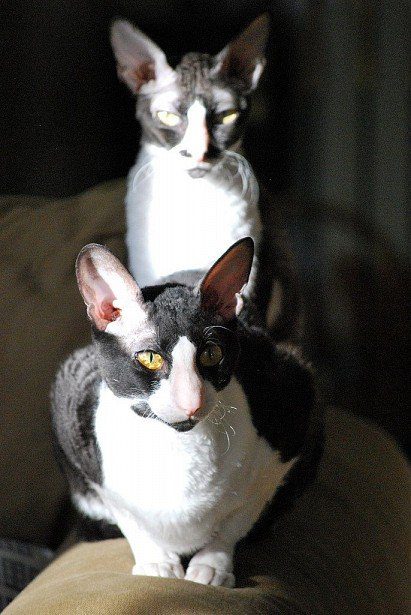
However, Foggy Albion was not the only haven of the new breed. In 1957, Francis Blancherie acquired two Cornish and ferried them from the British Isles to the United States. At the same time, one of the Rex (red color, also called “tabby” or “tabby”) did not acquire offspring. The blue beauty, named Lamorna Cove, was more fortunate: she arrived in America already almost on demolition and soon gave birth to two white-and-blue Cornish Rex. It is noteworthy that the long-suffering Englishman Poldu was the father of the kittens even before the ill-fated meeting with the veterinarian’s scalpel. With these charming kids, the spread of the breed throughout the United States began.
Before the charm of the offspring of Lamorna Cove, the breeder Ellen Weiss could not resist, who acquired one of the kittens and named him Marmaduke. From him later descended many lines of American Cornish. Wanting to move up a notch in the development of the breed, Weiss contacted the notorious Nina Ennismore, with whom she planned to make a lucrative deal and acquire more kittens for further breeding. However, by that time, Ennismore had already got rid of her pets and was forced to bite her elbows from her own short-sightedness: the amount offered by Ellen Weiss would more than compensate for any financial difficulties of a woman.
Once again, the Cornish Rex is endangered. In an attempt to prevent this, Diamond Lee crossed breeds with each other. Siamese , Burmese and American Shorthair cats became worthy genetic material for further breeding of Cornish cats . This experiment entailed minor changes in the appearance of the Rex, but at the same time gave them a huge variety of colors and colors. However, at present, crossing this breed with others is strictly prohibited.
In 1983, the largest felinological organizations officially registered the Cornish Rex. Now this breed is becoming increasingly popular due to its sophisticated aristocratic image and inexhaustible love for its owners.
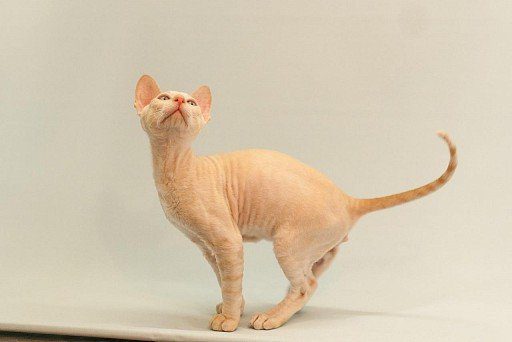
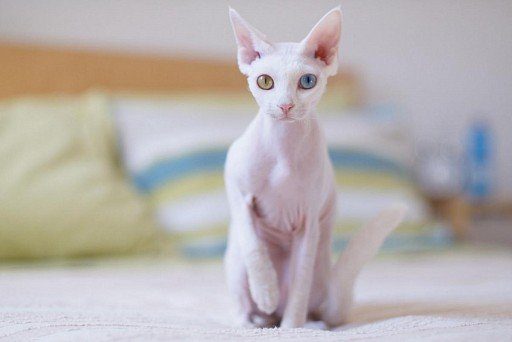
Video: Cornish Rex
Appearance of the Cornish Rex
Despite the fact that representatives of the breed look fragile and sophisticated, in reality everything is quite different. Curly hair, reminiscent of velvet to the touch, hides strong muscles and strong bones, while sharp claws and teeth are ready to fight with the offender. And the mass of animals is much larger than it seems: cats weigh from 4 to 5 kg, while cats – from 3 to 4 kg.
The Cornish Rex is a short-haired breed of medium to small size. At the same time, the American type looks more sophisticated and lighter than the English type.
Head and skull
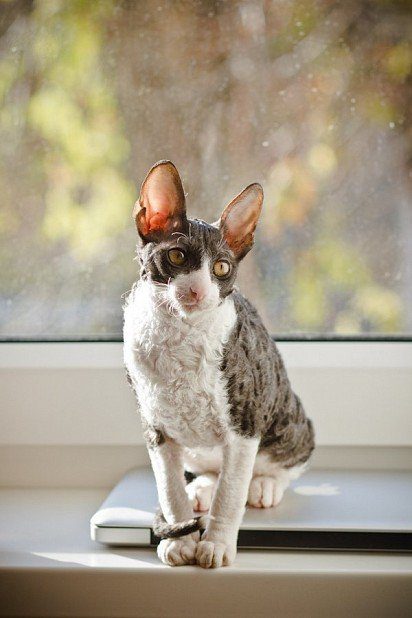
Natives of the United States are characterized by an egg-shaped head, while the native British can boast of its more triangular shape. At the same time, the width and length of the head of both types of breed are in the ratio 1:2. The skull is convex.
Muzzle
The muzzle of the Cornish Rex is shaped like a small wedge. The stop is moderately pronounced or completely even. The rounded forehead merges into a Roman type nose, the tip of which is located in the same vertical line with a strong chin. High cheekbones are clearly defined.
Ears
They have a wide base and a conical shape. Set relatively wide apart and of medium height. The tips of the ears are rounded, while the “triangles” themselves emphasize the wedge-shaped features of the muzzle.
Eyes
Slanted oval eyes are medium or large in size. They are fairly wide apart from each other. The pigmentation of the iris is rich and matches the color of the animal.
Jaws and teeth
The jaws of the Cornish Rex are surprisingly powerful. The bite is straight or scissor, slight overshot is allowed. The animal’s front teeth form a line that is clearly visible when the rex’s head is turned in profile. The upper and lower fangs are symmetrical, with the former slightly deepened.
Neck
The graceful and moderately long neck has well developed muscles.
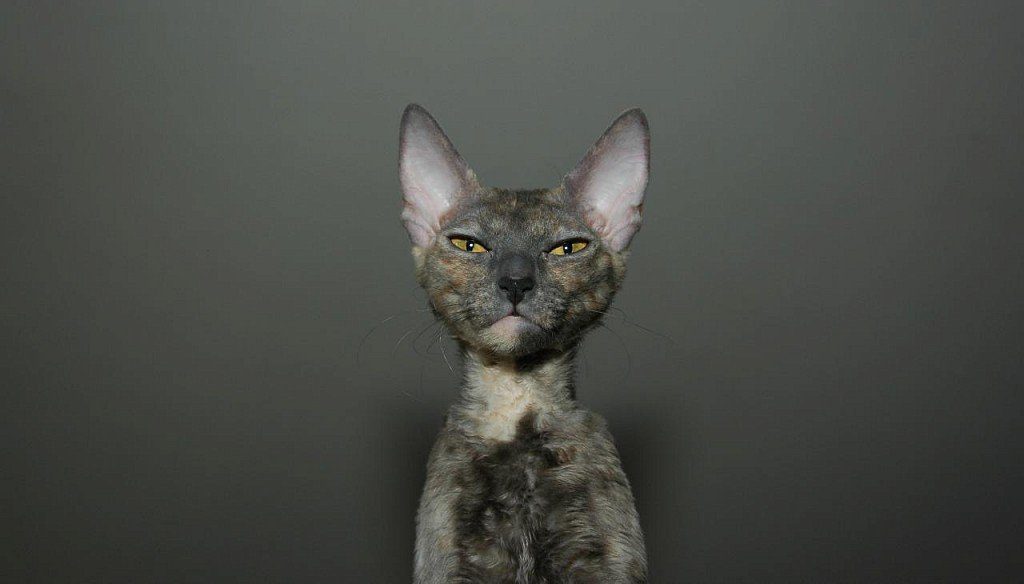
Frame
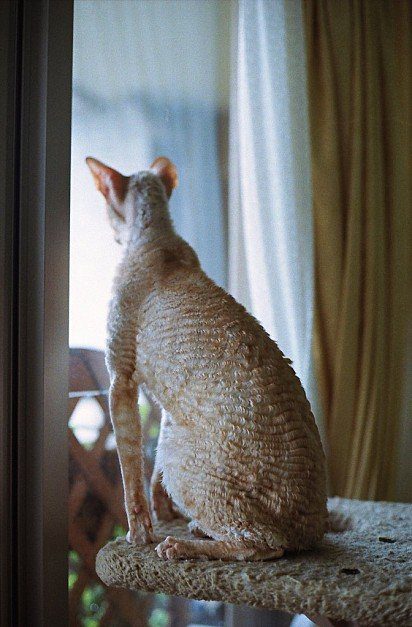
The Cornish Rex is the owner of a mobile and strong body. The body is slender and elongated, there is no hint of a cylindrical shape. The tucked up stomach slightly “flows”, which only emphasizes the arched back more strongly. Strong chest moderately broad. From certain angles, a slightly pronounced proportional waist is noticeable.
Tail
The thin tail of the animal is quite long and gradually tapers towards the tip. Mobility and flexibility gives it a resemblance to a whip.
limbs
The fore and hind limbs of the Cornish Rex are distinguished by thin bones that contrast with strong musculature. At the same time, the hind limbs are stronger, which allows the animal to make significant high jumps. The paws do not look massive, they have well developed and long fingers, collected in oval pads.
wool cover
Silky and soft to the touch coat is the main asset of the Cornish Rex breed. Despite the absence of a strong outer hair, it fits snugly to the body and lies in uniform waves. At the same time, on the lower part of the chin, chest and stomach of the cat, the hair is slightly shorter, but at the same time more curly.
Color
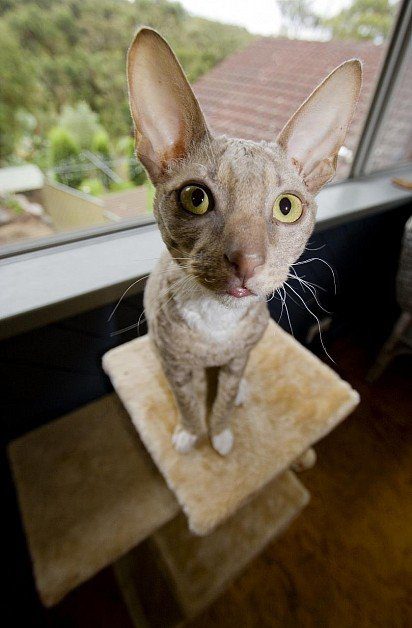
The color of the Cornish Rex can be absolutely any, both in the type of points and in the main color. Monochrome shade or classic tabby – the breed is really rich in all kinds of colors. Often there is a Siamese pattern. Individuals with this color are called “sea-rex”.
Possible vices
Cornish Rex breed defects include:
- short tail (completely bald or very shaggy);
- stocky or massive build;
- excessively long or wide head;
- rare wool cover;
- bald areas of the body;
- small ears.
Representatives of the breed may be disqualified for the following reasons:
- insufficiently velvety coat;
- the presence of coarse guard hair;
- atypical number of fingers;
- pronounced kink of the tail;
- amputated claws;
- deafness and/or lameness;
- undescended testicles.
Photo Cornish Rex
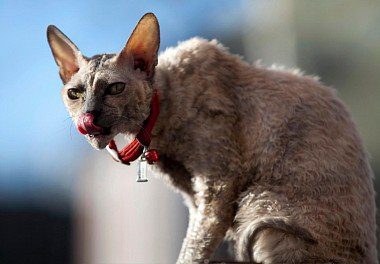
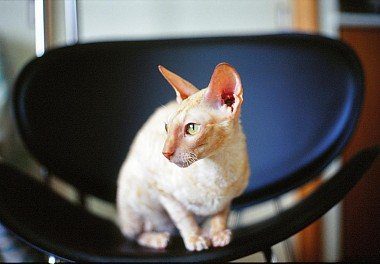
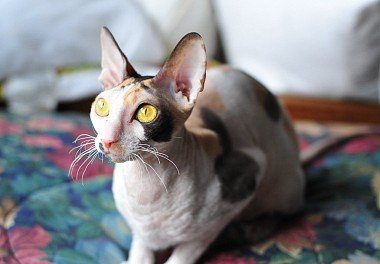
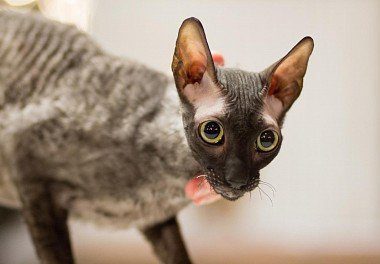
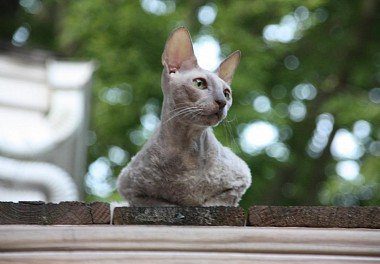
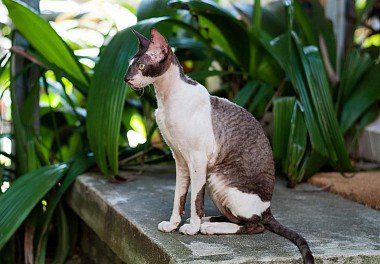
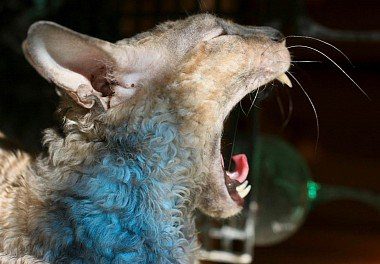
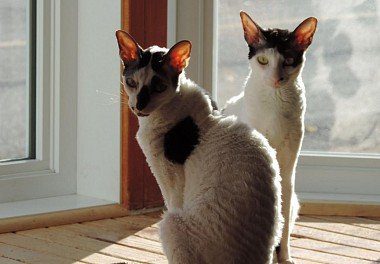
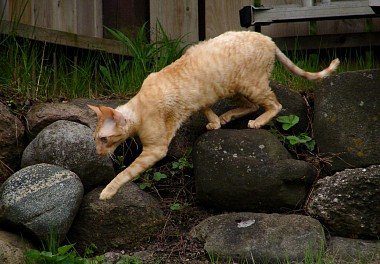
Personality of the Cornish Rex
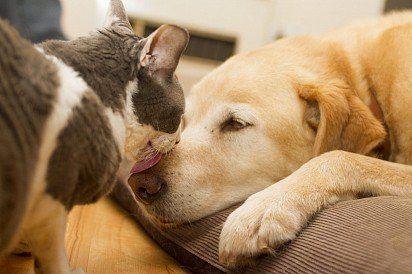
Are you repulsed by the outward resemblance of an animal to an unsociable bat or, even worse, an alien? Let this delusion sink into oblivion as soon as possible: the character of the Cornish Rex is truly unique and deserves your attention.
This breed is considered one of the most playful and active. Cornish Rexes will never become sofa cushions: basking in the rays of the morning sun and only occasionally stretching in response to the call is not in the nature of these cats. Animals love to explore the territory (albeit a familiar one for a long time), so they will not disregard either the roar of dishes in the kitchen, or a newspaper forgotten on the table, or a pigeon sitting on the windowsill.
Any object that catches the eye of a Cornish is automatically regarded as a toy, so try not to keep fragile and especially valuable things in sight. Provide “protection” for even the most remote shelves and cabinets, and even better, distract your pet’s attention with a timely thrown ball or purchased interactive toy. Recreating the Cornish Rex’s prey chase is just crazy!

The irrepressible attachment of representatives of the breed to their master will make even the most callous person let out a mean tear of tenderness. These cats can be very annoying, constantly spinning underfoot and making themselves felt with affectionate meows. However, at the same time, the animal will subtly feel the mood of a person and give the long-awaited loneliness, if he really wants it. In all other cases, you cannot escape the fate of being loved half to death. Butting, biting, licking, trampling – not the whole range of caresses that the Cornish bestow on their owners.
Representatives of this breed get along well with children, but are not enthusiastic about being constantly in their company. Of course, the animal will not show aggression towards the child, but it will prefer to hide from sight as soon as the opportunity arises.
Cornish Rex are wary of strangers and will not allow familiarity on their part. Keeping a distance is important for these animals; they are the first to start it and reduce it. As soon as the Cornish feels that there is no danger or threat coming from a person, he will gladly allow himself to be stroked and even jump on his hands, saying something in cat language.
When getting a Rex as a pet, be prepared for the fact that he cannot stand being alone. Locked doors and your long absence will force the animal to constantly meow and look for any opportunity to throw out the accumulated energy, which, by the way, is fraught with unpleasant consequences. For this reason, try to leave the Cornish in the company of another animal, but keep in mind that he may be jealous of other cats. It is not recommended to start decorative rodents and birds: this will awaken hunting instincts in the animal.
Cornish Rex is a breed that is characterized by softness and nobility. Nothing can bring the animal out of itself – except, perhaps, unpleasant hygiene procedures. Make sure in advance that an angry pet does not “reward” you with a couple of scratches in an attempt to dodge the nail cutter.
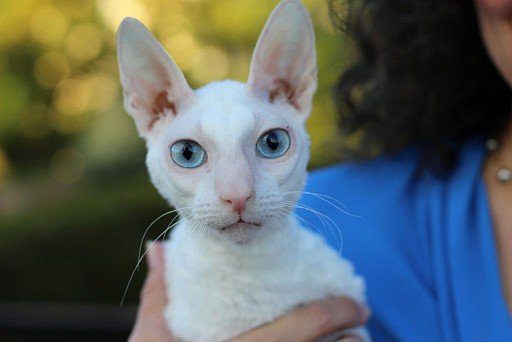
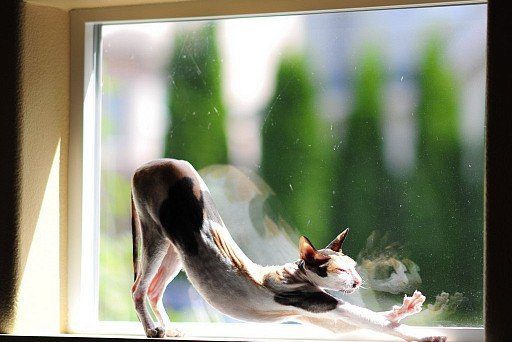
Education and training
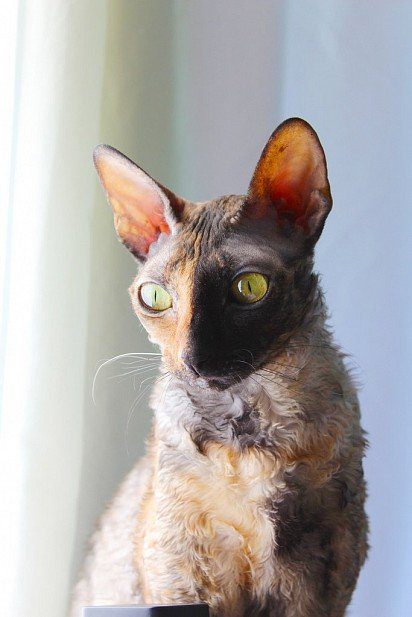
In the feline world, Cornish Rex are known to be real intellectuals, so they are easy to train, even as playful kittens.
As soon as the baby crosses the threshold of your house with his paws, draw a clear line between what you can and cannot do, and stick to this requirement throughout your pet’s life. At the same time, it is categorically not recommended to severely punish the Cornish for the slightest offense and raise your voice at him. To demonstrate discontent, it is enough to slap the newspaper on the floor near the animal, but in no case raise a hand to it. Otherwise, in the eyes of the Cornish, you will look like a threat, and not a source of love and affection.
Armed with patience, you can easily teach a representative of this breed the basic “dog” commands: sit, lie down, meow and even give a paw. Rex often learn to bring the owner a ball or other toy. These cats are calm about walking on a harness and, in general, their behavior is more reminiscent of dogs.
Cornish Rex perfectly understand the purpose of the tray and scratching posts, so there will be no problems with maintaining pet hygiene.
Care and maintenance
Representatives of this breed are not the most whimsical to care for, however, here you can meet your own nuances.
Since the coat of animals is characterized by the absence of a dense guard hair, skin secretions and sweat are not absorbed properly and thus necessitate weekly bathing of the Cornish. In this case, it is recommended to use special mild shampoos, otherwise the pet’s coat will lose its silkiness. After bath procedures, wrap the cat tightly in a towel so that it does not catch a cold. At the same time, it is necessary to eliminate even the slightest draft for the sake of your pet’s health.
Cornish Rex are not prone to frequent and heavy molting, so they get along well with people who suffer from wool allergies. To remove dead hairs, you do not need to buy special devices: just walk along the animal’s body with a damp piece of suede.
Representatives of this breed are famous for their small paws and therefore never completely hide their claws. If they do not grind naturally, it’s time to arm yourself with a nail cutter or purchase a scratching post. To attract the attention of a pet, you can sprinkle it with valerian extract or decorate it with something.
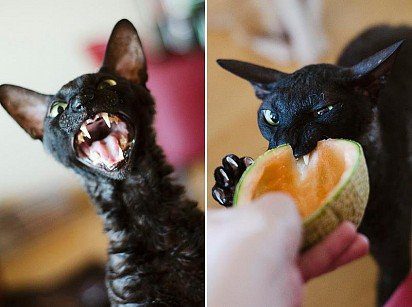
Check your Cornish’s eyes and ears regularly for any discharge, making sure to wipe them daily with a cotton swab. For greater effect, you can moisten it with tea leaves. Please note that this procedure is especially disliked by all Cornish, so wait until your pet is in a playful and favorable mood to avoid problems. If the animal refuses to be handled, leave this matter to the veterinarian and wait until the cat gets used to the discomfort over time.
Oral care is also essential. Once a month, brush your pet’s teeth with a special toothpaste. At the same time, make sweeping movements from the base to the edge of the tooth.
The active lifestyle of the Cornish Rex is the main reason why he constantly feels hungry. It is highly recommended not to overfeed your pet as this breed is prone to obesity. The daily norm of elite food is more than enough. At the same time, from time to time it is necessary to dilute the animal’s diet with natural food. Ideally, you should adhere to a certain feeding regime, otherwise your pet will beg you for a tidbit every now and then.
Never feed a Cornish Rex:
- excessively salty and sweet foods;
- small and large bones;
- pork in any form;
- legumes;
- mushrooms and nuts;
- river fish;
- milk;
- liver.
As for drinking water, you should not “please” your pet with tap water, although this is the easiest option. Bottled water from underground sources will perfectly quench the thirst of the Cornish Rex, while not rewarding him with diseases. If you can’t afford bottled water all the time, use filtered water or wait until the tap water is infused in a tightly closed vessel for 7-8 hours.
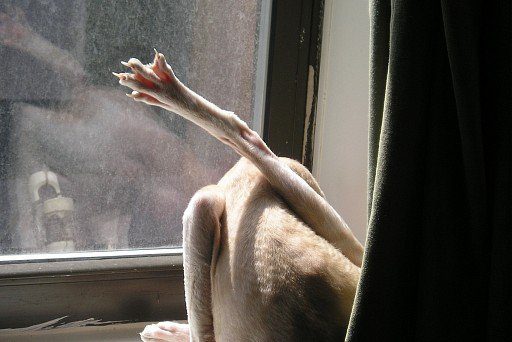
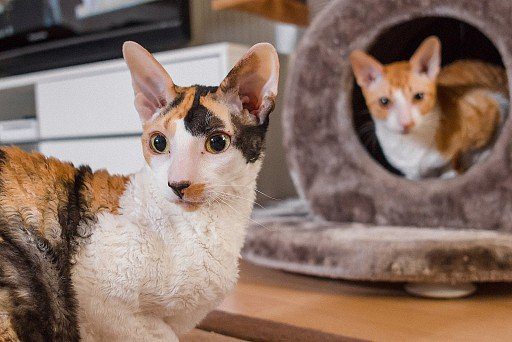
Health and disease of the Cornish Rex
Representatives of this breed are characterized by good health and the absence of specific diseases. However, the Cornish still have weaknesses. Common illnesses include:
- disturbed metabolism;
- retinal atrophy;
- “greasy tail”;
- hypokalemia;
- alopecia.
In order to avoid health problems in your pet, it is necessary to visit the veterinarian regularly for preventive examinations. Timely vaccination (and it is permissible already from the age of three months of the animal) is no less important. Paying due attention to the Cornish Rex, you will get a healthy and, most importantly, happy pet, which will often delight you with its antics.
How to choose a kitten
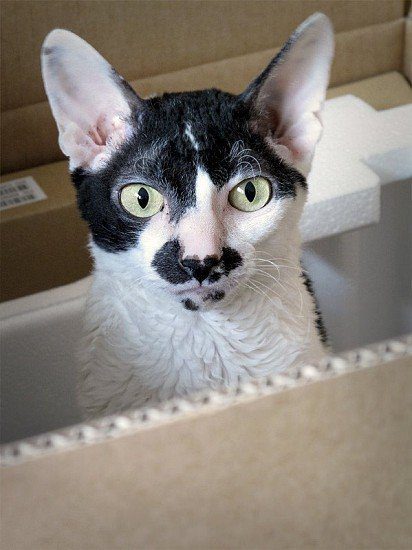
Going in search of your best friend, be guided by a simple rule: do not listen to anyone but yourself! The breeder’s insistent recommendations about which kitten to buy do not always have a positive connotation. Rely only on your own intuition and do not forget that Cornish Rex can choose their owner based on instincts.
Ideally, kittens are weaned from their mother at 2.5 months of age. Otherwise, you risk acquiring a pet with unbalanced psychological and physical health.
It is undesirable to buy Cornish Rex in the so-called bird markets: saving on the price of the animal will later result in huge costs for restoring the pet’s well-being. An ideal place to purchase a kitten will be a cattery. Do not be afraid to seem intrusive to the breeder by asking questions: usually conscientious breeders are happy to talk about their wards and, at the first request, show a veterinary passport and other important documents.
When meeting children, pay attention to their behavior. Marked the most active and cheerful? Take it: it’s yours! But lethargic kittens that do not take part in the game with their brethren should be bypassed: they are probably sick and will add a lot of trouble to you in the future.
Photo of Cornish Rex kittens
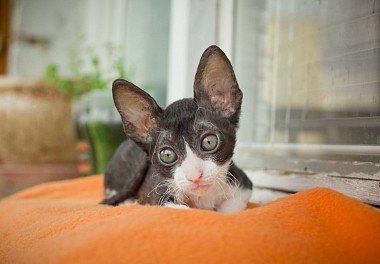

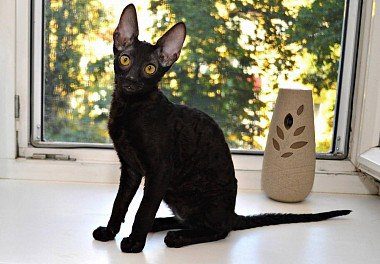
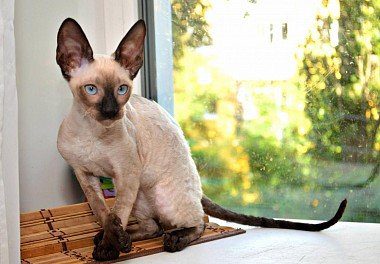
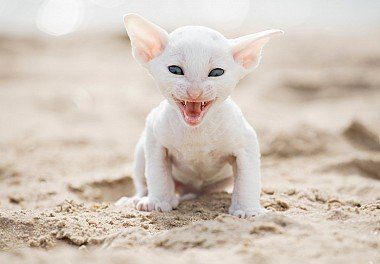

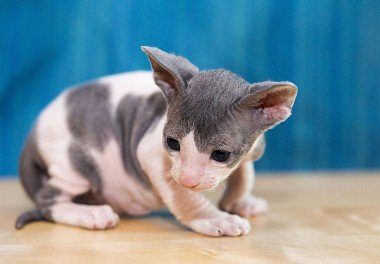
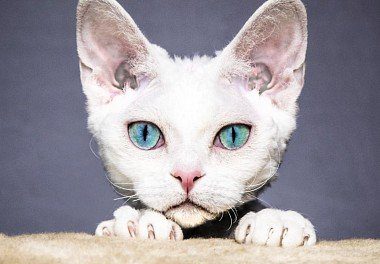
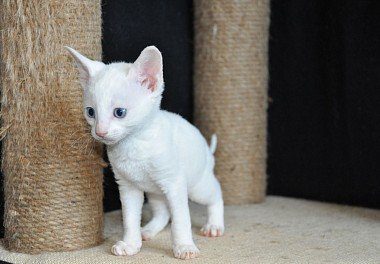
How much is a Cornish Rex
“Kittens from the same litter should cost the same” is the main misconception of many. Unfortunately, this is not the case: the cost of a Cornish Rex is determined by its belonging to one of three classes:
- show (from 800$ and more);
- Brid (from 400-800$);
- pet (from 150-400$).
To participate in exhibitions and a possible victory in them, it is customary to buy show-class Cornish Rex. Cats and cats of the “breed” category are intended for breeding and are therefore famous for their excellent pedigree. Animals of the pet-class are turned on for the soul. At the same time, the latter are often sold for castration, since they are not suitable for breeding due to certain breed defects. If you are not deterred by the wrong tail bend or the under-refined Cornish physique, opt for a pet category. It is more than enough to get a devoted and loving friend!



